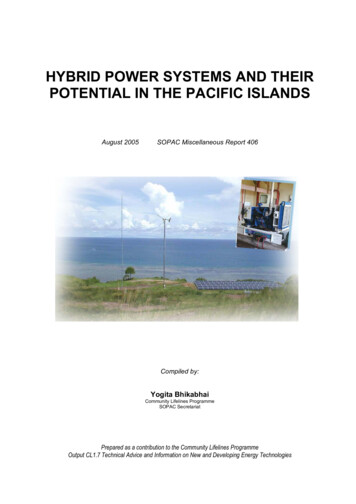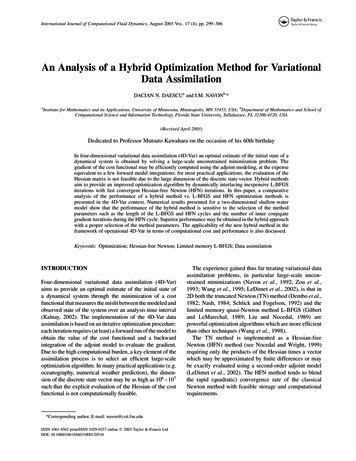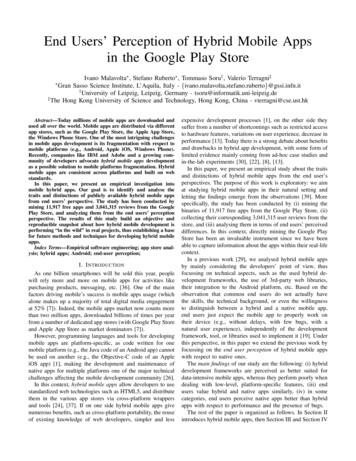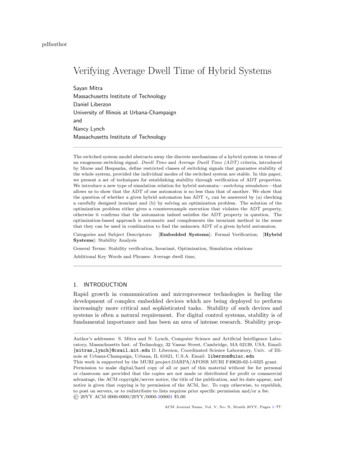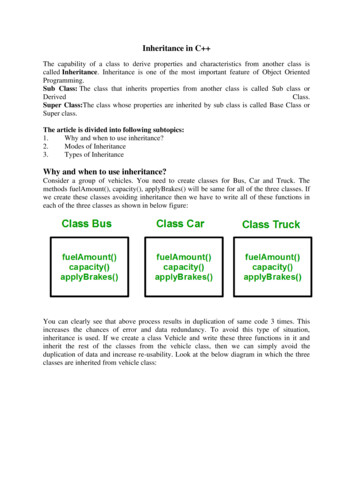
Transcription
11Optimum Design of a HybridRenewable Energy SystemFatemeh Jahanbani and Gholam H. RiahyElectrical Engineering Department, Amirkabir University of TechnologyIran1. IntroductionIn Iran, 100% of the region populated with more than 20 families is electrified. For the otherregions the electrification will be done. These regions almost are rural and remote areas. Forutility company it is important that electrification be done with the least cost.Many alternative solutions could be used for this goal (decreasing the cost). Usingrenewable energy system is one of the possible solutions. A growing interest in renewableenergy resources has been observed for several years, due to their pollution free energy,availability, and continuity. In practice, use of hybrid energy systems can be a viable way toachieve trade-off solutions in terms of costs. Photovoltaic (PV) and wind generation (WG)units are the most promising technologies for supplying load in remote and rural regions[Wang et al., 2007]. Therefore, in order to satisfy the load demand, hybrid energy systemsare implemented to combine solar and wind energy units and to mitigate or even cancel outthe power fluctuations. Energy storage technologies, such as storage batteries (SBs) can beemployed. The proper size of storage system is site specific and depends on the amount ofrenewable energy generation and the load.Many papers are discussed on design of hybrid systems with the different components.Also, various optimization techniques are used by researchers to design hybrid energysystem in the most cost effective way.Rahman and Chedid give the concept of the optimal design of a hybrid wind–solar powersystem with battery storage and diesel sets. They developed linear programming model tominimize the average production cost of electricity while meeting the load requirements in areliable manner, and takes environmental factors into consideration both in the design andoperation phases [Chedid et al., 1997]. In [Kellogg et al, 1996], authors proposed an iterativetechnique to find the optimal unit sizing of a stand-alone and connected system. In 2006 ispresented a methodology for optimal sizing of stand-alone PV/WG systems using geneticalgorithms. They applied design approach of a power generation system, which supplies aresidential household [Koutroulis et al, 2006]. In [Ekren, 2008], authors used the responsesurface methodology (RSM) in size optimization of an autonomous PV/wind integratedhybrid energy system with battery storage. In [Shahirinia, 2005], an optimized design ofstand-alone multi sources power system includes sources like, wind farm, photovoltaicarray, diesel generator, and battery bank based on a genetic algorithm is presented. Also,authors in [Koutroulis et al, 2006, Tina, 2006] used multi-objective genetic algorithm, inwww.intechopen.com
232Renewable Energy – Trends and Applicationsorder to calculate reliability/cost implications of hybrid PV/wind energy system in smallisolated power systems. Yang developed a novel optimization sizing model for hybridsolar–wind power generation system [Yang et al., 2007]. In [Terra, 2006] an automatic multiobjective optimization procedure base on fuzzy logic for grid connected HSWPS design isdescribed. In some later works, PSO is successfully implemented for optimal sizing ofhybrid stand-alone power systems, assuming continuous and reliable supply of the load[Lopez, 2008, Belfkira, 2008]. Karki and Billinton presented a Monte-Carlo simulationapproach to calculate the reliability index [Karki et al., 2001] and Kashefi presented amethod for assessment of reliability basis on binominal distribution function for hybridPV/wind/fuel cell energy system that is used in this study [Wang et al., 2007].As previous studies shown, renewable energies are going to be a main substitute for fossilfuels in the coming years for their clean and renewable nature [Sarhaddi et al., 2010].Photovoltaic solar and wind energy conversion systems have been widely used forelectricity supply in isolated locations that are far from the distribution network.The future of power grids is expected to involve an increasing level of intelligence andintegration of new information and communication technologies in every aspect of theelectricity system, from demand-side devices to wide-scale distributed generation to avariety of energy markets.In the smart grid, energy from diverse sources is combined to serve customer needs whileminimizing the impact on the environment and maximizing sustainability. In addition tonuclear, coal, hydroelectric, oil, and gas-based generation, energy will come from solar,wind, biomass, tidal, and other renewable sources. The smart grid will support not onlycentralized, large-scale power plants and energy farms but residential-scale disperseddistributed energy sources [Santacana et al., 2010].Being able to accommodate distributed generation is an important characteristic of the smartgrid. Because of mandated renewable portfolio standards, net metering requirements and adesire by some consumers to be green, there is an increasing need to be prepared to be ableto interconnect generation to distribution systems, especially renewable generation such asphotovoltaic, small wind and land fill gas powered generation [Saint, 2009].The future electric grid will invariably feature rapid integration of alternative forms for energygeneration. As a national priority, renewable energy resources applications to offset thedependence on fossil fuels provide green power options for atmospheric emissionscurtailment and provision of peak load shaving are being put in policy [Santacana et al., 2010].Fortunately, Iran is a country with the adequate average of solar radiation and wind speedfor setting up a hybrid power generation e.g. the average of wind speed and perpendicularsolar radiation were recorded for Ardebil province is 5.5945 m/s and 203.1629 W/m2respectively in a year.In this study, an optimal hybrid energy generation system including of wind, photovoltaicand battery is designed. The aim of design is to minimize the cost of the stand-alone systemover its 20 years of operation. The optimization problem is subject to economic and technicalconstraints. Figure1 show the framework of activities in this study.The generated power by wind turbine and PV arrays are depended on many parametersthat the most effectual of them are wind speed, the height of WTs hub (that affects the windspeed), solar radiations and orientation of PV panels. In certain region, the optimizationvariables are considered as the number of WTs, number of PV arrays, installation angle ofPV arrays, number of storage batteries, height of the hub and sizes of DC/AC converter. Thewww.intechopen.com
Optimum Design of a Hybrid Renewable Energy System233goal of this study is optimal design of hybrid system for the North West of Iran (Ardebilprovince). The data of hourly wind speed, hourly vertical and horizontal solar radiation andload during a year are measured in the region. This region is located in north-west of Iranand there are some villages far from the national grid. The optimization is carried out byParticle Swarm Optimization (PSO) algorithm. The objective function is cost withconsidered economical and technical constraints. Three different scenarios are consideredand finally economical system is selected.Fig. 1. The framework of activitiesThis study is organized as follows: section 2 describes the modeling of system components.The reliability assessment is discussed in section 3. Problem formulation and operationstrategy are explained in section 4 and 5, respectively. In the next section, is dedicated toparticle swarm optimization. Simulation and results are summarized in section 7. Finally,section 8 is devoted to conclusion.2. Description of the hybrid systemThe increasing energy demand and environmental concerns aroused considerable interest inhybrid renewable energy systems and its subsequent development.The generation of both wind power and solar power is very dependent on the weatherconditions. Thus, no single source of energy is capable of supplying cost-effective andreliable power. The combined use of multiple power resources can be a viable way toachieve trade-off solutions. With combine of the renewable systems, it is possible that powerfluctuations will be incurred. To mitigate or even cancel out the fluctuations, energy storagetechnologies, such as storage batteries (SBs) can be employed [Wang et al., 2009].The proper size of storage system is site specific and depends on the amount of renewablegeneration and the load. The needed storage capacity can be reduced to a minimum when aproper combination of wind and solar generation is used for a given site [Kellogg, 1996].The hybrid system is shown in Fig. 2. In the following sections, the model of components isdiscussed.www.intechopen.com
234Renewable Energy – Trends and ApplicationsFig. 2. Block diagram of a hybrid wind/photovoltaic generation unit2.1 The wind turbineChoosing a suitable model is very important for wind turbine power output simulations.The most simplified model to simulate the power output of a wind turbine could becalculated from its power-speed curve. This curve is given by manufacturer and usuallydescribes the real power transferred from WG to DC bus.The model of WG is considered BWC Excel-R/48 (see Fig. 3) [Hakimi et al., 2009]. It has arated capacity of 7.5 kW and provides 48 V dc as output. The power of wind turbine isdescribed in terms of the wind speed according to Eq. 1.Fig. 3. Power output characteristic of BWC Excel R/48 versus wind speed [Hakimi, 2009]. 0vW vci , vW vco m v vci PW PWmax Wvci vW vr vr vci Pf PWmax P vW vr vr vW v f Wmaxvco vrwww.intechopen.com(1)
235Optimum Design of a Hybrid Renewable Energy Systemwhere PWGmax , Pf are WG output power at rated and cut-out speeds, respectively. Also, vr ,vci , vco are rated, cut-in and cut-out wind speeds, respectively. In this study, the exponent mis considered 3. In the above equation, vW refers to wind speed at the height of WG’s hub.Since, vW almost is measured at any height (here, 40 m), not in height of WGs hub, is used Eq.(2) to convert wind speed to installation height through power law [Borowy et al., 1996]: measure hhub vW vW hmeasure (2)where α is the exponent law coefficient. α varies with such parameters as elevation, time ofday, season, nature of terrain, wind speed, temperature, and various thermal andmechanical mixing parameters. The determination of α becomes very important. The valueof 0.14 is usually taken when there is no specific site data (as here) [Yang et al., 2007].2.2 The photovoltaic arrays (PVs)Solar energy is one of the most significant renewable energy sources that world needs. Themajor applications of solar energy can be classified into two categories: solar thermalsystem, which converts solar energy to thermal energy, and photovoltaic (PV) system,which converts solar energy to electrical energy. In the following, the modeling of PV arraysis described.For calculating the output electric power of PVs, perpendicular radiation is needed. Whenthe hourly horizontal and vertical solar radiation is available (as this study), perpendicularradiation can be calculated by Eq. (3):G t , PV GV t cos PV GH t sin PV (3)where, GV t and GH t are the rate of vertical and horizontal radiations in the tth steptime (W/m2), respectively. The radiated solar power on the surface of each PV array can becalculated by Eq. (4):Ppv G Ppv ,rated MPPT1000(4)where, G is perpendicular radiation at the arrays’ surface (W/m2). Ppv , rated is rated power ofeach PV array at G 1000( W / m2 ) and MPPT is the efficiency of PV’s DC/DC converterand Maximum Power Point Tracking (MPPT).2.3 The storage batteriesSince both wind and PVs are intermediate sources of power, it is highly desirable toincorporate energy storage into such hybrid power systems. Energy storage can smooth outthe fluctuation of wind and solar power and improve the load availability [Borowy et al.,1996].When the power generated by WGs and PVs are greater than the load demand, the surpluspower will be stored in the storage batteries for future use. On the contrary, when there isany deficiency in the power generation of renewable sources, the stored power will be usedto supply the load. This will enhance the system reliability.www.intechopen.com
236Renewable Energy – Trends and ApplicationsIn the state of charge, amount of energy that will be stored in batteries at time step of t iscalculated: EB t EB t 1 Pw Ppv t PLoad t / inv. Bat (5)In addition, Eq. 6 will calculate the state of battery discharge at time step of t: EB t EB t 1 PLoad t / inv. Pw Ppv t Bat(6)where, EB t , EB t 1 are the stored energy of battery in time step of t and (t-1). Pw , Ppvare the generated power by wind turbines and PV arrays, PLoad t is the load demand attime step of t and Bat is the efficiency of storage batteries.2.4 The power inverterThe power electronic circuit (inverter) used to convert DC into AC form at the desiredfrequency of the load. The DC input to the inverter can be from any of the following sources:1. DC output of the variable speed wind power system2. DC output of the PV power systemIn this study, supposed the inverter’s efficiency is constant for whole working range ofinverter (here 0.9).3. The reliability assessmentA widely accepted definition of reliability is as follows [Billinton, 1992]: “Reliability is theprobability of a device performing its purpose adequately for the period of time intendedunder the operating conditions encountered”. In the following sections, reliability indicesand reliability model that is used in this study is described.3.1 Reliability indicesSeveral reliability indices are introduced in literature [Billinton, 1994, XU et al., 2005]. Some ofthe most common used indices in the reliability evaluation of generating systems are Loss ofLoad Expected (LOLE), Loss of Energy Expected (LOEE) or Expected Energy not Supplied(EENS), Loss of Power Supply Probability (LPSP) and Equivalent Loss Factor (ELF).In this study, ELF is chosen as the main reliability index. On the other word, the ELF indexis chosen as a constraint that must be satisfied but it could be possible to calculate the otherindexes as is done in this study (such as EENS, LOLE and LOEE indexes).ELF is ratio of effective load outage hours to the total number of hours. It containsinformation about both the number and magnitude of outages. In the rural areas and standalone applications (as this study), ELF 0.01 is acceptable. Electricity supplier aim at 0.0001in developed countries [Garcia et al., 2006]:ELF 1 H E(Q( h )) H h 1 D( h )(7)where, Q(h) and D(h) are the amount of load that is not satisfied and demand power in hthstep, respectively and H is the number of time steps (here H 8760).www.intechopen.com
Optimum Design of a Hybrid Renewable Energy System237In this study, the reliability index is calculated from component’s failure, that is concludingof wind turbine, PV array, and inverter failure.3.2 System’s reliability modelAs mentioned, outages of PV arrays, wind turbine generators, and DC/AC converter aretaken into consideration. Forced outage rate (FOR) of PVs and WGs is assumed to be 4%[Karki et al., 2001]. So, these components will be available with a probability of 96%.Probability of encountering each state is calculated by binomial distribution function[Nomura 2005].For example, given nWG fail out of total NWG installed WGs, and nPV fail out of total NPVinstalled PV arrays are failed, the probability of encountering this state is calculated asfollows: failfail n fail fail fail n fail N WG nN PV nnnf ren n fail , n fail WG AWG WG 1 AWG WG PV APV PV 1 APV PV (8)WGPV N WG N PV The outage probability of other components is negligible. But, because, DC/AC converter isthe only single cut-set of the system reliability diagram, the outage probability of it is takenconsideration (it’s FOR is considered 0.0011 [Kashefi et al., 2009]).In [Kashefi et al., 2009] an approximate method is used that proposed all the possible statesfor outages of WGs and PV arrays to be modeled with an equivalent state. This idea ismodeled by Eq. 7.E Pren N WG PWG AWG N PV PPV APV(9)4. Problem formulationThe economical viability of a proposed plant is influence by several factors that contribute tothe expected profitability. In the economical analysis, the system costs are involved as:Capital cost of each componentReplacement cost of each componentOperation and maintenance cost of each componentCost costumer’s dissatisfactionIt is desirable that the system meets the electrical demand, the costs are minimized and thecomponents have optimal sizes. Optimization variables are number of WGs, number of PVarrays, installation angle of PV arrays, number of storage batteries, and sizes of DC/ACconverter. For calculation of system cost, the Net Present Cost (NPC) is chosen.For optimal design of a hybrid system, total costs are defined as follow:NPCi N i (CCi RCi Ki O & MCi 1 / CRF ir , R )(10)where N may be number (unit) or capacity (kW), CC is capital cost (US /unit), O&MC isannual operation and maintenance cost (US /unit-yr) of the component. R is Life span ofproject, ir is the real interest rate (6%). CRF and K are capital recovery factor and singlepayment present worth, respectively.www.intechopen.com
238Renewable Energy – Trends and Applications irnominal f 1 f ir CRF ir , R Ki yin 1ir 1 ir (11)R 1 ir R 1 1 ir n L1i(12)(13)4.1 The cost of loss of loadIn this study, cost of electricity interruptions is considered. The values found for thisparameter are in the range of 5-40 US /kWh for industrial users and 2-12 US /kWh fordomestic users [Garcia et al., 2006]. In this study, the cost of customer’s dissatisfaction,caused by loss of load, is assumed to be 5.6 US /kWh [Garcia et al., 2006].Annual cost of loss of load is calculated by:NPC loss LOEE C loss PWA(14)where, C loss is cost of costumer’s dissatisfaction (in this study, US 5.6/kWh). Now, theobjective function with aim to minimize total cost of system is described:Cost NPC i NPC loss(15)iwhere i indicates type of the source, wind, PV, or battery. To solve the optimizationproblem, all the below constraints have to be considered:0 N i N max10 H hub 200 PV & PVT Ebatmin Ebat Ebatmax2(16)E ELF ELFmaxThe last constraint is the reliability constraint. Equivalent Loss Factor is ratio of effectiveload outage hours to the total number of hours. In the rural areas and stand-aloneapplications (as this study), ELF 0.01 is acceptable [Tina, 2006]. For solving the optimizationproblem, particle swarm algorithm has been exploited.5. Operation strategyThe system is simulated for each hour in period of one year. In each step time, one of thebelow states can occur:If the total power generated by PV arrays and WGs are greater than demanded load,the energy surplus is stored in the batteries until the full energy is stored. Theremainder of the available power is consumed in the dump load.www.intechopen.com
Optimum Design of a Hybrid Renewable Energy System239-If the total power generated by PV arrays and WGs are less than demanded load,shortage power would be provided from batteries. If batteries could not provide totalenergy that loads demanded, the load will be cut.If the total power generated by PV arrays and WGs are equal to the demanded load, thestorage capacity remains unchanged and all of the generated power will be consumedat the load.By consideration these states and all the constraints, the optimal hybrid system is calculated.6. Optimization methodFor size optimization of components PSO algorithm is used. Direct search method(traditional optimization method) heavily depends on good starting points, and may fallinto local optima. On the other hand, as a global method for solving both constrained andunconstrained optimization problems based on natural evolution, the PSO can be applied tosolve a variety of optimization problems that are not well suited for standard optimizationalgorithms. Moreover, the GA can also be employed to solve a variety of optimizationproblems. Compared to GA, the advantages of PSO are that PSO is easy to implement andthere are few parameters to adjust. PSO has been successfully applied in many areas.6.1 The PSO algorithmParticle swarm optimization was introduced in 1995 by Kennedy and Eberhart. Thefollowing is a brief introduction to the operation of the PSO algorithm. The particle swarmoptimization (PSO) algorithm is a member of the wide category of swarm intelligencemethods for solving global optimization problems. PSO is an evolutionary algorithmtechnique through individual improvement plus population cooperation and competitionwhich is based on the simulation of simplified social models, such as bird flocking, fishschooling and the swarm theory [Jahanbani et al., 2008].Each individual in PSO, referred as a particle, represents a potential solution. In analogywith evolutionary computation paradigms, a swarm is similar to population, while aparticle is similar to an individual.In simple terms, each particle is flown through a multidimensional search space, where theposition of each particle is adjusted according to its own experience and that of itsneighbors.Assume x and v denote a particle position and its speed in the search space. Therefore, theith particle can be represented as xi [ xi1 , xi2 ,., xid ,., xiN ] in the N-dimensional space. Eachparticle continuously records the best solution it has achieved thus far during its flight. Thisfitness value of the solution is called pbest. The best previous position of the ith particle ismemorized and represented as:pbesti [ pbesti1 , pbesti2 ,., pbestid ,., pbestiN ](17)The global best gbest is also tracked by the optimizer, which is the best value achieved so farby any particle in the swarm. The best particle of all the particles in the swarm is denoted bygbestd. The velocity for particle i is represented as vi [ vi1 , vi2 ,., vid ,., viN ] .The velocity and position of each particle can be continuously adjusted based on the currentvelocity and the distance from pbestid to gbestd:www.intechopen.com
240Renewable Energy – Trends and Applicationsvi (t 1) (t )vi (t ) c1r1 ( Pi (t ) Xi (t )) c2r2 (G(t ) X(t ))(18)Xi (t 1) Xi (t ) vi (t 1)(19)where c1 and c2 are acceleration constants and r1 and r2 are random real numbers drawnfrom [0,1]. Thus the particle flies trough potential solutions toward Pi (t ) and G(t ) in anavigated way while still exploring new areas by the stochastic mechanism to escape fromlocal optima.Since there was no actual mechanism for controlling the velocity of a particle, it wasnecessary to impose a maximum value Vmax, which controls the maximum travel distance ineach iteration to avoid this particle flying past good solutions. Also after updating thepositions, it must be checked that no particle violates the boundaries of search space. If aparticle has violated the boundaries, it will be set at boundary of search space [Jahanbani etal., 2008].In Eq. (20), (t ) is employed to control the impact of the previous history of velocities onthe current one and is extremely important to ensure convergent behavior. It is exposedcompletely in the following section. (t ) is the constriction coefficient, which is used torestrain velocity. is constriction factor which is used to limit velocity, here 0.7 .7. Simulation resultsThe first goal of each planning in electrical network is that the system meets the demand.For satisfying this goal, the cost of costumer’s dissatisfaction is considered as well as theother costs. Flowchart of the proposed optimization methodology is shown in Fig. 4. Thehourly data of wind speed, vertical and horizontal solar radiation and residential loadduring a year is plotted in Fig. 5, Fig. 6 and Fig. 7, respectively. The data that used in thisstudy is the data of Ardebil convince that is located in the North West of Iran (latitude:38 17 , longitude: 48 15 , altitude: 1345 m). The peak load is considered as 50 kW. In table 1,data that used in the simulation are listed.Fig. 4. Flowchart of the proposed optimization methodology.www.intechopen.com
241Optimum Design of a Hybrid Renewable Energy SystemSystem parametersvaluesSystem parametersvaluesEfficiency of SB85%Replacement price of PVarray6000 US /unitEfficiency of inverter90%Replacement price of SB700 US /unitLife span of project20Replacement price ofinverter750 US /unitLife span of WTG and PV20OM costs of inverter8 US /unit-yrLife span of SB10Cut-in wind speed3 m/sLife span of inverter15Rated wind speed13 m/s7000 US /unitCut-out wind speed25 m/s19400US /unitRated WTG power7.5 kW800 US /unitMinimum storage level ofbattery3 kWh15000US /unitMaximum total SB capacity40 kWhPV array priceWTG priceInverter priceReplacement price ofWTGTable 1. Data used for simulation program [Tina et al., 2006, Khan et al., 2005]25Annual wind speed (m/s)201510500100020003000Fig. 5. Hourly wind speed during a year.www.intechopen.com40005000Time (hour)6000700080009000
242Renewable Energy – Trends and Applications1000Annual radiation 40005000600070008000Time (hour)Fig. 6. Hourly vertical and horizontal solar radiation during a year.5045Load power (kW)40353025201510010002000300040005000Time (hour)6000700080009000Fig. 7. Hourly residential load during a year.It is noticeable that the technical constraint, related to system reliability, is expressed by theequivalent loss factor. The reliability index is calculated from component’s failure, thatincludes wind turbine, PV array, battery and inverter failure. The power generated by eachwind turbine and PV array can be derived by Eq. (1) and Eq. (3), respectively. The totalpower that can be generated with NWG wind turbines and NPV PV arrays that nWG and nPV ofall wind turbines and PV arrays are out of work, respectively, will be calculated as follows:Pren ( N WG nWG ) AWG PWG ( N PV nPV ) APV PPVwww.intechopen.com(20)
243Optimum Design of a Hybrid Renewable Energy SystemAs previously mentioned, the reliability constraint is considered as the penalty factor in theobjective function. To consider the constraint of reliability in Eq. (16), the excess amount ofinequality constraint is multiplied by 1010 and then, this additional cost is added to theobjective function in Eq. (15). With this method, the NPC of the system that couldn't satisfythe reliability constraint will increase, and then this system would not be chosen as the besteconomic system.One of the best methods in the planning area is using scenario method. To choose the bestplan (the minimum cost) different scenarios is implemented. In this study, the optimal sizeof components for hybrid system is calculated in three scenarios based on proposedapproach. These systems are PV/battery system, wind/battery system andPV/wind/battery system. For each system the minimum cost and reliability indices iscalculated. The results are shown in the following.As mentioned before, in this study particle swarm optimization algorithm is used for optimalsizing of system’s components. Each particle has 6 variables that are defined as below:Number ofwind turbineNumber ofPV arrayAngle of PVBatterycapacityHeight of hubInvertercapacityFig. 8. A typical vector for a particleEach population consists of 30 particles that are calculated for 120 iterations. The fitnessfunction is defined in Eq. (15). It must be considered that if the costs of loss of load are moreexpensive than the cost of bigger system, the bigger system will be chosen because it iseconomically reasonable.7.1 Scenario I: Wind/PV/battery hybrid systemIn this case, a stand-alone hybrid system is considered that is including of wind and PVenergy sources and storage batteries. Convergence curves of the PSO algorithm, for fiveindependent runs, are shown in Fig. 9. It is observed that the algorithm converges almost tothe same optimal value.Hourly generated power of PV arrays, WGs is shown in Fig. 10 that could be comparingwith load. The hourly expected amount of stored energy in the battery is shown in Fig.10, too. It is significant that reliable supply of the load at each time step, strongly,depends on the amount of the stored energy. When stored energy in battery reaches itsminimum allowable limit, if renewable system cannot satisfy the load, the load will notbe supplied. On the other hand, if renewable system can satisfy the load, the extragenerated energy will be saved in the battery (and battery is in the state of charge). It isworth pointing out that when the battery has the maximum charge its energy will notincrease anymore.In Fig. 11, the hourly reliability indices in the year are plotted. The amount of hourlydemand and load pattern is another important factor in reliability assessment of the system.The size of each component is also calculated and is shown in table 2.As shown in the above figures, each time step could be analyzed. For example, at around of6500th time step, the power that is generated by PV arrays and wind turbines is decreased(Fig. 10) and it is not enough to satisfy the load. Also, the energy that saved in the batteriesin this step is around the minimum allowable level. So, some of the demand is lost and ELFindex is equal to 0.5 (Fig. 11).www.intechopen.com
244Renewable Energy – Trends and Applications62.6x 102.4Total cost (US )2.221.81.61.41.210.80.6020406080Number of iteration100120Fig. 9. Convergence of
Optimum Design of a Hybrid Renewable Energy System 235 where WG max P , P f are WG output power at rated and cut-out speeds, respectively. Also, vr, vci, vco are rated, cut-in and cut-ou t wind speeds, respectively. In this study, the exponent m is considered 3. In the above equation, vW refers to wind speed at


